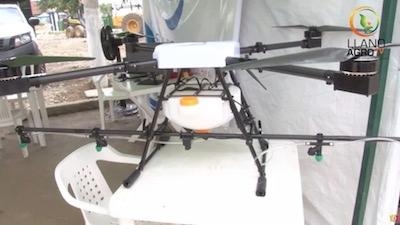Wed, Aug 22, 2018
Ten Drones Being Tested In Nariño Province
The Colombian government is testing a fleet of 10 drones to destroy coca plants that are used in the production of cocaine.

Drone DJ relays a report from the Wall Street Journal which indicates that the new President of Colombia, Iván Duque, prefers using drones over manned aircraft to protect neighboring crops from damage.
The tests are being conducted in the southwestern portion of Nariño province. The drones carry the herbicide Glyphosate, a defoliant, and spray the coca plants with far greater accuracy than could be achieved using more traditional methods. The previous President of Colombia, Juan Manuel Santos, had halted spraying by 14 crop duster airplanes after local farmers filed lawsuits who were concerned about their health. Glyphosate has been linked to some cancers by the World Health Organization.
The U.S. EPA has said that glyphosate is "unlikely" to cause cancer. The chemical has been part of a $10 billion foreign aid package called "Plan Colombia". Use of the chemical reduced the country's coca fields from 470,000 acres in 2001 to 193,000 acres in 2012. But by 2017, the acreage had again increased 160 percent to 516,000 acres.
The drones have been provided by Fumi Drones SAS. German Huertas, director of operations at Fumi Drone says that the aircraft can eliminate about 90 percent of the crops on every acre of coca plants. They also fly lower to the ground, and do not pose a safety hazard to pilots flying close to the ground, Huertas said. The company is also training local police to fly the aircraft.
The downside is that the drones carry a much smaller load of the defoliant than a crop duster, and police must cordon off an area to be sprayed to prevent local farmers from being exposed or cocaine manufacturers from shooting them out of the air. There are also a large number of landmines buried in many regions from a long rebel conflict in Colombia, which can pose additional threats to soldiers and drone pilots.
(Image provided by Llano AgroTV)
More News
He Attempted To Restart The Engine Three Times. On The Third Restart Attempt, He Noticed That Flames Were Coming Out From The Right Wing Near The Fuel Cap Analysis: The pilot repor>[...]
Make Sure You NEVER Miss A New Story From Aero-News Network Do you ever feel like you never see posts from a certain person or page on Facebook or Instagram? Here’s how you c>[...]
From 2009 (YouTube Edition): Leading Air Show Performers Give Their Best Advice for Newcomers On December 6th through December 9th, the Paris Las Vegas Hotel hosted over 1,500 air >[...]
Aero Linx: NASA ASRS ASRS captures confidential reports, analyzes the resulting aviation safety data, and disseminates vital information to the aviation community. The ASRS is an i>[...]
“For our inaugural Pylon Racing Seminar in Roswell, we were thrilled to certify 60 pilots across our six closed-course pylon race classes. Not only did this year’s PRS >[...]
 NTSB Final Report: Rutan Long-EZ
NTSB Final Report: Rutan Long-EZ ANN FAQ: Turn On Post Notifications
ANN FAQ: Turn On Post Notifications Classic Aero-TV: ICAS Perspectives - Advice for New Air Show Performers
Classic Aero-TV: ICAS Perspectives - Advice for New Air Show Performers ANN's Daily Aero-Linx (06.28.25)
ANN's Daily Aero-Linx (06.28.25) Aero-News: Quote of the Day (06.28.25)
Aero-News: Quote of the Day (06.28.25)



